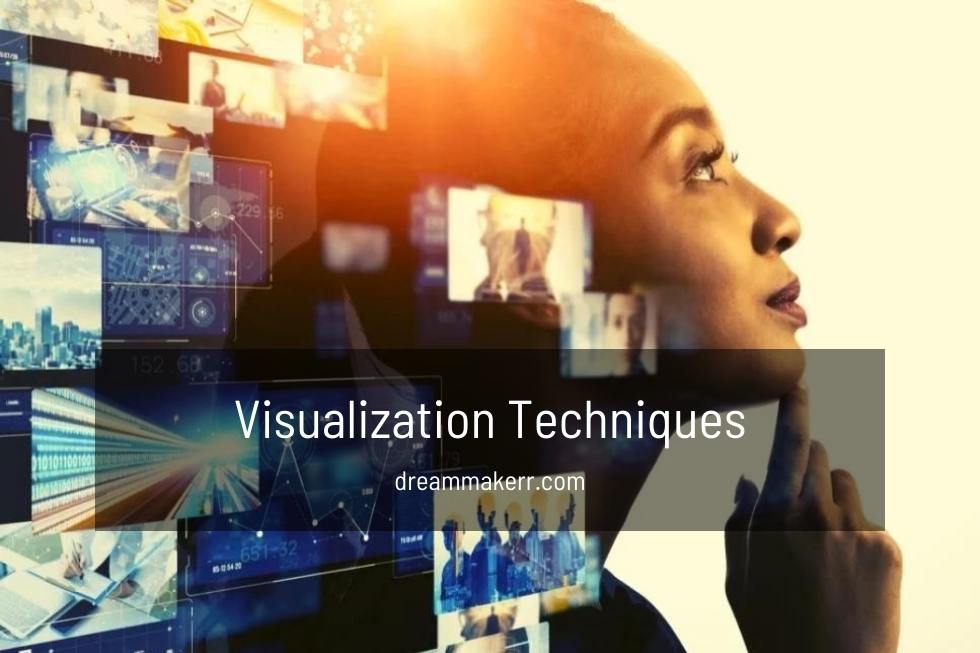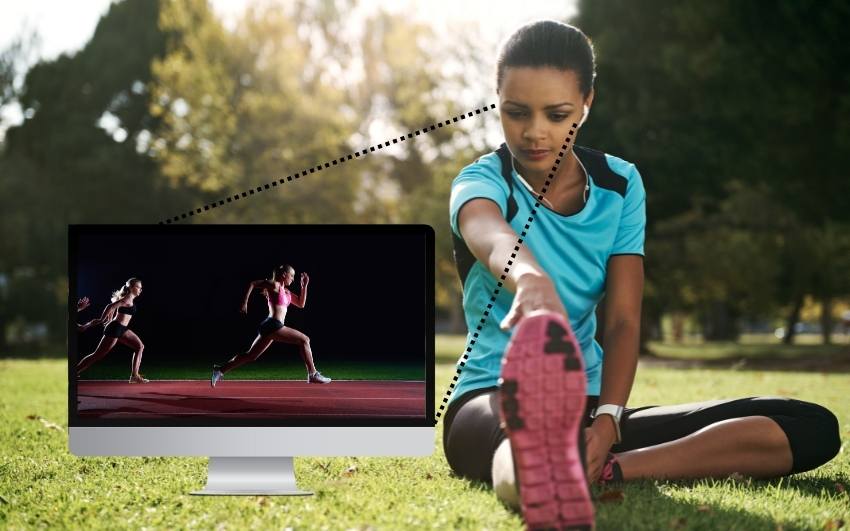On this page

5 Visualization Techniques To Help You Achieve Your Goals
For centuries, people from all corners of the globe have employed various visualization techniques, meditations, and prayers. However, many see visualization as something impractical or even “out there” that isn’t rooted in reality.
Contrary to popular belief, you don’t need to possess spiritual qualities or beliefs to benefit from visualizations. Psychologists have studied the power of visualization and how it works. Nowadays, everyone – from athletes to leaders of organizations – is taking advantage of these techniques!
It’s time to explore what visualization truly entails and why it is imperative. Then, let us dive into some of the visualization methods you can utilize immediately!
Visualization: what it is, what it isn’t

Visualization is a powerful practice that allows you to manifest what you desire for your future. Utilizing all five senses – sight, smell, touch, taste, and hearing – helps create an understanding of the end goal in your subconscious mind. The constant reminder encourages consistency and trains the brain to respond as if those outcomes have already been achieved. Visualization can be incredibly effective when incorporated into daily life!
Visualization can be divided into two distinct categories:
- Outcome visualization: Imagining the objective destination that you wish to reach.
- Process visualization: Visualizing each milestone that leads to the desired conclusion. Utilize all five senses in this journey!
When used together, the two visualizations are far more effective than separately.
What visualization is
- Seeing something with your mind
- Creating a mental image of your goal
- Create a mental picture of something that doesn’t exist yet
- Imagining seeing something happen
- Rehearsing a specific outcome
What visualization is not
- Visualization is not just wishful thinking
- It’s not about fantasizing or daydreaming about what you want
Why is Visualizing Important For Your Life?

Visualization is an intentional and practical approach to achieving your goals. It involves more than just daydreaming; you must take active steps toward getting what you want!
Our lives are surrounded by a plethora of digital stimulation, from the near-endless cycle of news and entertainment to our newfound ability to work remotely with just one click. It can be easy for us to succumb to distraction in this modern world.
Feeling overwhelmed by the lack of time can be all too common.
You want a moment to relax and concentrate on what matters most.
In his insightful speech, Unleash Your Super Brain to Learn Faster, Jim Kwik effectively uses powerful metaphors that are sure to inspire you!
You can decide whether to use a thermostat or a thermometer when controlling your destiny. The thermostat reacts to the environment, whereas the thermometer creates and adjusts its temperature. A visualization is an effective tool that enables you to design and manifest the future of your dreams.
You can train your mind to focus on what matters most with creative visualization. This technique of determining important information is known as selective attention and has been used for centuries by successful people.
You ever purchase a car, and then out of nowhere, you spot the exact vehicle all around town? It’s true – we choose to focus on what we will see! This phenomenon called selective attention is best exemplified in the widely popular video Test Your Awareness: Do the Test.
Paying close attention to what you do and making conscious efforts will help make your dreams a reality, whether positive or negative. Have you ever experienced the fear that comes with picturing potentially devastating results – only for them to come true?
Imagine your best-case outcome and revel in its joys with all your senses.
How does that make you feel?
To find the answer, we can refer to cognitive behavior theory. This school of thought states that our thoughts come before anything else – and thus, visualization is based on this same principle.
Taking the concept of imagination to a higher level, visualization is an effective technique that allows your brain to record what you want in the future as if it’s already happened. By picturing yourself achieving success and portraying every detail with all five senses, you are sending out a strong message – one that will manifest itself into reality!
What Are Visualization Techniques Used For?

Some people may think that visualization techniques are only for people who are very creative or “out there.”
However, it can be utilized to help you concentrate on and work toward your ideal future condition or to boost your self-confidence.
Visualizing your future ideal state can be a powerful motivational tool to help you focus and propel you forward.
1. Boost Self Confidence
Additionally, visualization exercises are an effective way of boosting self-confidence; imagine yourself giving an inspiring presentation in front of hundreds and receiving thunderous applause! This kind of positive mental imagery increases the likelihood that you will take action exponentially.
2. Mental Rehearsal
Visualization can act as a form of practice in your head. By visualizing the process, you sharpen your focus and engage the neural pathways that help refine actions before they are executed on stage. This will better prepare you to step out with confidence and grace!
Your movements are envisioned and predestined to execute the predetermined actions. You may include these steps as part of a more extensive long-term plan, such as a 5-year plan.
Visualization techniques can significantly reduce stress and anxiety as they help refocus your attention on the desired outcome, eliminating other competing distractions.
3. Reduce anxiety
Visualization techniques can also reduce anxiety. They direct your attention back to the details of your desired outcome. In the process, minimizing the noise of other (less relevant) distractions.
How Do You Visualize What You Want?

When you keep these things in mind, you’ll be well on achieving anything you set your mind to:
- First, you have to do the research and know precisely what you want. This includes setting realistic goals and understanding what’s required to achieve them.
- Next, you need to get into the right mindset. This means getting rid of any doubts or negative thoughts that could sabotage your efforts.
- Next, become clear about your values and what you’re willing to do to achieve your goals. This will help you stay motivated when things get tough.
- Then, it’s time to create a mental image or movie of your desired outcome.
- Finally, it’s essential to focus on the present moment. Visualize what you’re doing right now that will lead to your desired outcome. See yourself taking action and achieving your goal. Focus on how good it feels to be successful.
Read more: How to visualize
Does Visualization Really Work?

Searching Google for the word “visualization” will yield many accounts of world-class athletes who cultivated a mental edge to excel in their sport. By dwelling on proper techniques ahead of time, these competitors can enter their competitive spaces with confidence and precision.
For example:
- Accomplished rock climber Alex Honnold.
- Renowned former Navy Seals like David Goggins and Jocko Willink
- Michael Phelps is the most decorated Olympian of all time, with 28 Olympic medals and an impressive career in competitive swimming.
- Famous NBA athlete LeBron James is dominating the basketball court.
- Renowned Olympic diver Greg Louganis, holder of multiple gold medals.
Stroke victims have successfully exercised their minds through visualization to promote neuroplasticity. Just like physical exercise, mental activity can be equally influential in promoting a healthy body and mind. Through this form of “mental gymnastics,” stroke sufferers can regain control over parts of the body affected by the trauma.
Chess prodigy Beth Harmon reaches unprecedented heights through visualization in the acclaimed Netflix series Queen’s Gambit. Initially captured by the game, she commits to becoming an unparalleled master and reads up on all available literature about it to succeed.
She hones her skills by studying every available play; then, before bed, she imagines the moves of upcoming chess matches in vivid detail. Similarly to a dancer rehearsing for an offstage performance, she visualizes each step and gesture while simultaneously picturing the audience’s reaction. After executing the routine on stage and watching it back with the judges’ comments, she considers these notes when practicing again.
She refines the strategies she practices and visualizes the process in her mind, continuously repeating it until she perfects its execution. She also recreates this same procedure physically to strengthen her skillset further.
Can you recall when you had the perfect picture of what could be? The actions that were necessary to make it happen. Did everything go exactly as planned?
If so, then you know that wasn’t just luck—it was driven by desire and focus. Your neurons (neuroplasticity) lit up with enthusiasm for your intended result, guiding each thought and behavior toward its fruition.
Read more: Visualization power
5 Steps to Practice Visualization

Here are five steps to get you started on your visualization practice:
- Determine what you want to achieve. Write down your goal in as much detail as possible. What does it look like, heavy, oversized, or minor? What’s the vibe around that thing? Write it all out.
- What’s the emotion attached to the outcome? How will you feel once you achieve that goal? Get in touch with those emotions and let them flow through your body. How do you feel when you’ve reached that goal?
- Create scenes before, during, and after. Create a movie with 3 images showing what happens first, second, and third. What does it look like after you’ve achieved it?
- Get into a receptive mode. Find a quiet place where you can relax and focus your attention inward. Relax yourself using meditation or breathing techniques.
- Begin to visualize yourself achieving your goal. See yourself in your mind’s eye, succeeding at what you set out to do. Imagine the 3 scenes happening; you’re there, and you’re inside the movie that you want to create. Look around using your 3 stages.
Harness The Power of Visualization Through Techniques and Tools
Learning how to visualize effectively can be a challenge, but these five tools and techniques will help you master the art of creative visualization:
1. Use a guided visualization recording
Use a guided visualization meditation. They are becoming more and more popular. If you’re feeling stressed, an interactive visualization can help you relax and refocus on your goals. If you’re creative you can create one yourself or purchase one online for $80-$180.
2. Create a vision board
Many people prefer this approach as it becomes a physical prop to help them imagine and visualize their goals. A vision board involves a short but effective creative process, including cutting and gluing paper, ideas, images that will evoke emotions, and words that you find in magazines. You can also make a digital one.
3. Use an Index card to write down your goals
Use a big index card and write one goal on each side. You can display these around your house or keep them in your wallet as a physical reminder of what you’re working towards.
4. Try Creative Visualization
One of the most popular manifestation techniques is creative visualization—picturing yourself in the life you want, already. “When you close your eyes and see yourself already living in abundance, feeling happy, doing what you love every day, that’s when your subconscious mind starts to match up with your desires,” Petri says.
5. Make a Scrapbook
This is a fun way to record your dreams, aspirations, and goals. Plus, it’s a great way to display your progress. You can use old photos, magazine clippings, postcards, and anything else that inspires you.
6. Create a Mood Board
A mood board is similar to a vision board, but it’s more focused on emotions and feelings. It’s a collection of images, colors, and textures that evoke a certain mood. This can be a great way to visualize what you want your life to feel like.

Petri Maatta is a mindset coach and neuroscience-focused author with 15 years of experience in personal transformation and success psychology. After seven years of business failures, he discovered the power of manifestation through a Fortune 500 mentor. Now, he shares neuroscience-backed strategies through DreamMaker membership, helping others transform their businesses and lives on their own terms.
Read My Story here.
Share This Story, Choose Your Platform!
You want to manifest a new car, but you’re wondering: Does this really work? Here’s
Many smart individuals are often linked with having a high IQ. However, according to emotional
According to online dating statistics over 90% of people believe in love at first sight,




